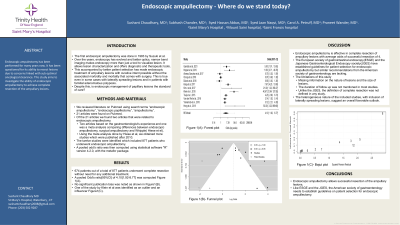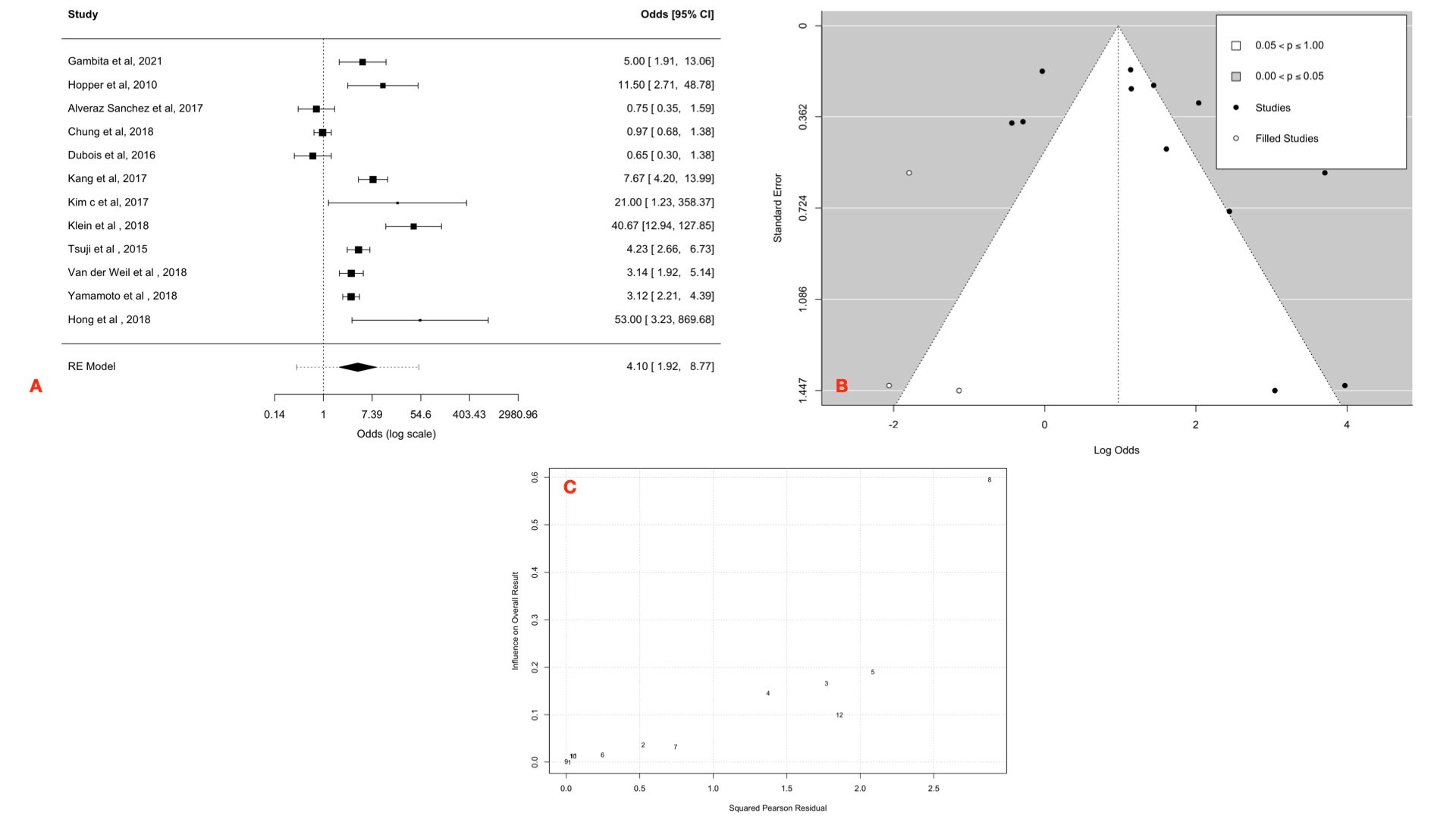Back


Poster Session B - Monday Morning
Category: Biliary/Pancreas
B0021 - Endoscopic Ampullectomy - Where Do We Stand Today?
Monday, October 24, 2022
10:00 AM – 12:00 PM ET
Location: Crown Ballroom

Has Audio
- SC
Sushant Chaudhary, MD
St. Mary's Hospital
Middlebury, CT
Presenting Author(s)
Sushant Chaudhary, MD1, Sayeed Jaan Naqvi, MD2, Subhash Chander, MD2, Sayed Hassan Abbas, MD2, Carol A. Petruff, MD3, Praneet Wander, MD4
1St. Mary's Hospital, Middlebury, CT; 2St. Mary's Hospital, Waterbury, CT; 3St. Francis Hospital, Avon, CT; 4Saint Mary's Hospital, Waterbury, CT
Introduction: The first endoscopic ampullectomy was done in 1983 by Suzuki et al. Since then the technique has been questioned regarding its place in management of ampullary lesions due concerns linked with oncological clearance. The European society of Gastrointestinal endoscopy(ESGE) and the Japanese Gastroenterological Endoscopy society(JGES) have recommendations on endoscopic ampullectomy but American Society of Gastrointestinal endoscopy does not have similar recommendations. Fritzsche et al used Delphi method to draft recommendations but no consensus was reached on 51% of questions.
This study aims to investigate the ability of endoscopic ampullectomy to achieve complete resection of the ampullary lesions.
Methods: We reviewed the literature from 2010 to 2022 to evaluate endoscopic ampullectomy for its ability to resect the ampullary lesions completely. "Endoscopic ampullecomy", "endoscopic papillectomy" were used as search words in Pubmed.
A pooled odd's ratio was then computed. Statistical software "R" version 4.2.0 was used for data analysis.
Results: We identified 21 studies, two of these studies provided information on successful resection and one was a meta analysis comparing endoscopic ampullectomy with surgical ampullectomy/ pancreatic duodenctomy. Ten more articles were identified from this meta analysis and included in our study. A total of 877 patients were included from a total of 12 studies. 674 patients had complete resection and did not require any additional treatment.
A pooled Odd's ratio[95%CI] of 4.10[1.92-8.77] was computed Figure 1(A). No significant publication bias was noted Figure1(B).One of the study by Kim et al was identified as an outlier and an influencer Figure1(C).
Discussion: Endoscopic ampullectomy is effective in complete resection of ampullary lesions with average odds of successful resection of 4. The limitations of this study stems of missing information on the nature of lesions and the size of lesions resected. Also the duration of follow up was not included in most studies. Unlike the JGES, the definition of complete resection was not defined in any study.
However the study provides supportive evidence that resection of ampullary lesions is possible endoscopically, without the morbidity and mortality associated with Whipple procedure/ Surgical ampullectomy.

Disclosures:
Sushant Chaudhary, MD1, Sayeed Jaan Naqvi, MD2, Subhash Chander, MD2, Sayed Hassan Abbas, MD2, Carol A. Petruff, MD3, Praneet Wander, MD4. B0021 - Endoscopic Ampullectomy - Where Do We Stand Today?, ACG 2022 Annual Scientific Meeting Abstracts. Charlotte, NC: American College of Gastroenterology.
1St. Mary's Hospital, Middlebury, CT; 2St. Mary's Hospital, Waterbury, CT; 3St. Francis Hospital, Avon, CT; 4Saint Mary's Hospital, Waterbury, CT
Introduction: The first endoscopic ampullectomy was done in 1983 by Suzuki et al. Since then the technique has been questioned regarding its place in management of ampullary lesions due concerns linked with oncological clearance. The European society of Gastrointestinal endoscopy(ESGE) and the Japanese Gastroenterological Endoscopy society(JGES) have recommendations on endoscopic ampullectomy but American Society of Gastrointestinal endoscopy does not have similar recommendations. Fritzsche et al used Delphi method to draft recommendations but no consensus was reached on 51% of questions.
This study aims to investigate the ability of endoscopic ampullectomy to achieve complete resection of the ampullary lesions.
Methods: We reviewed the literature from 2010 to 2022 to evaluate endoscopic ampullectomy for its ability to resect the ampullary lesions completely. "Endoscopic ampullecomy", "endoscopic papillectomy" were used as search words in Pubmed.
A pooled odd's ratio was then computed. Statistical software "R" version 4.2.0 was used for data analysis.
Results: We identified 21 studies, two of these studies provided information on successful resection and one was a meta analysis comparing endoscopic ampullectomy with surgical ampullectomy/ pancreatic duodenctomy. Ten more articles were identified from this meta analysis and included in our study. A total of 877 patients were included from a total of 12 studies. 674 patients had complete resection and did not require any additional treatment.
A pooled Odd's ratio[95%CI] of 4.10[1.92-8.77] was computed Figure 1(A). No significant publication bias was noted Figure1(B).One of the study by Kim et al was identified as an outlier and an influencer Figure1(C).
Discussion: Endoscopic ampullectomy is effective in complete resection of ampullary lesions with average odds of successful resection of 4. The limitations of this study stems of missing information on the nature of lesions and the size of lesions resected. Also the duration of follow up was not included in most studies. Unlike the JGES, the definition of complete resection was not defined in any study.
However the study provides supportive evidence that resection of ampullary lesions is possible endoscopically, without the morbidity and mortality associated with Whipple procedure/ Surgical ampullectomy.

Figure: Figure 1- A) Shows the forest plot with odds ratio from the individual studies and pooled Odd's ratio, The results have been subjected to exponential axis transformation.
B) Funnel plot showing the publication bias.
C) Buajat plot
B) Funnel plot showing the publication bias.
C) Buajat plot
Disclosures:
Sushant Chaudhary indicated no relevant financial relationships.
Sayeed Jaan Naqvi indicated no relevant financial relationships.
Subhash Chander indicated no relevant financial relationships.
Sayed Hassan Abbas indicated no relevant financial relationships.
Carol Petruff indicated no relevant financial relationships.
Praneet Wander indicated no relevant financial relationships.
Sushant Chaudhary, MD1, Sayeed Jaan Naqvi, MD2, Subhash Chander, MD2, Sayed Hassan Abbas, MD2, Carol A. Petruff, MD3, Praneet Wander, MD4. B0021 - Endoscopic Ampullectomy - Where Do We Stand Today?, ACG 2022 Annual Scientific Meeting Abstracts. Charlotte, NC: American College of Gastroenterology.
